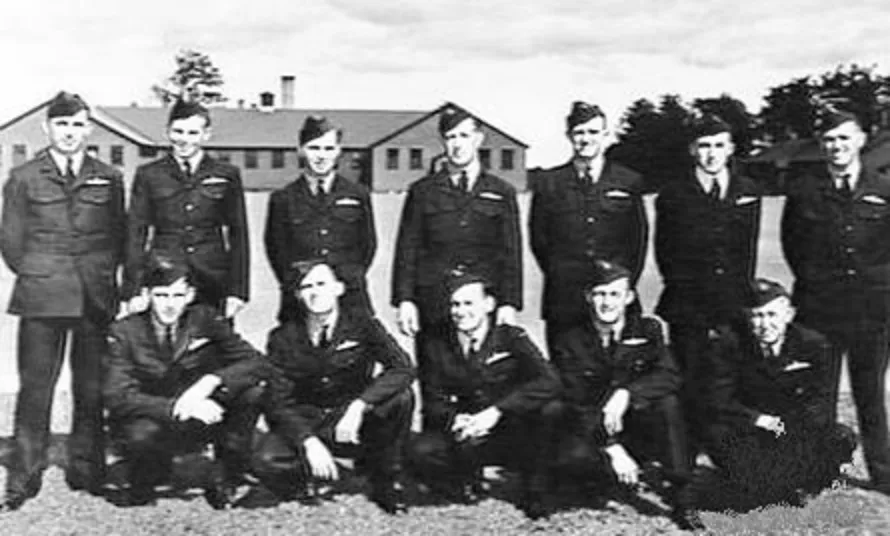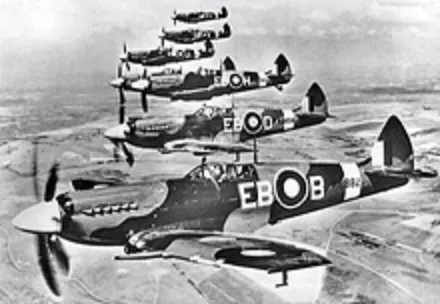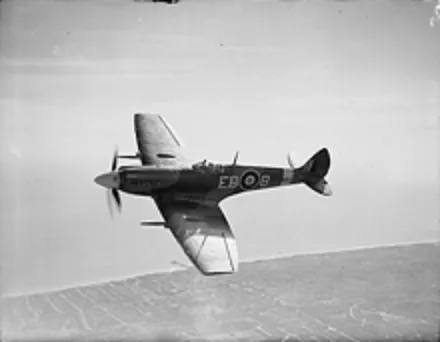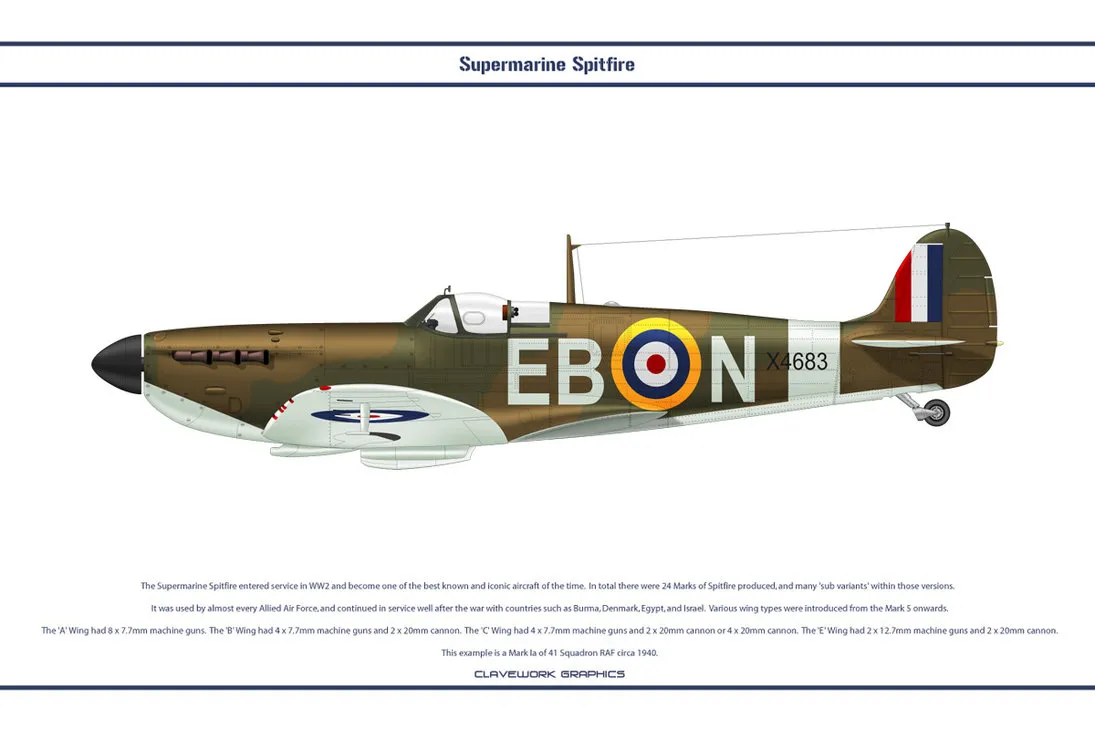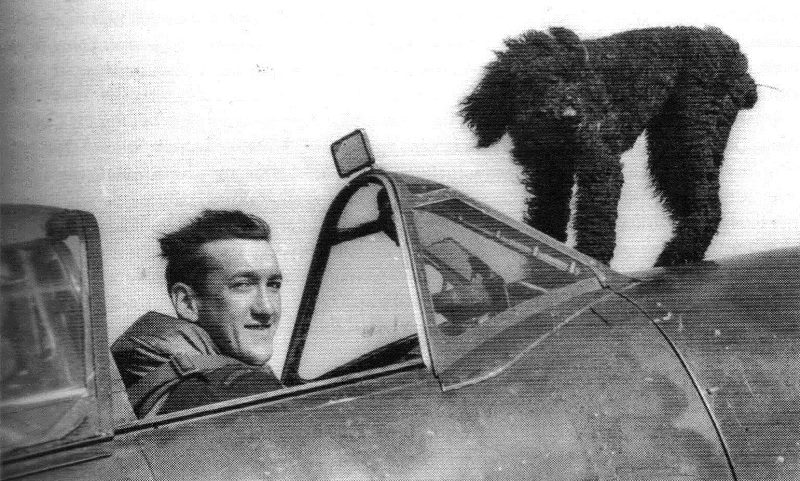No 41 Squadron RAF
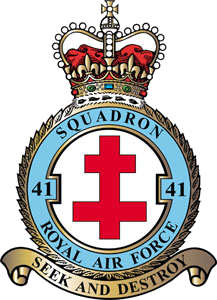


Following the declaration of War on 3 September 1939, 41 Squadron spent the first several months on monotonous routine patrols in the north of England. At the end of May 1940, the Squadron flew south to RAF Hornchurch to participate in the evacuation of Dunkirk. Twelve days later, they returned to RAF Catterick, claiming six enemy aircraft destroyed and one probable, but also left behind two pilots, the Squadron's first pilot killed in action and their first lost as a Prisoner of War.
After resting for a few weeks, the Squadron headed south again on 26 July 1940, to participate in the first phase of the Battle of Britain. In its two-week tour, the Squadron claimed 10 enemy aircraft destroyed, 4 probable and 3 damaged, for the loss of one pilot killed and a second wounded.
Again, 41 Squadron returned north to Catterick for a few weeks rest, but returned to Hornchurch on 3 September 1940, where they remained until the end of February 1941. They were now in the thick of the Battle of Britain. The price was high, but so was the damage they inflicted on the Luftwaffe. On 5 September, the Squadron experienced one of its blackest days in its history. The Commanding Officer and OC, B Flight, were killed in action and three other pilots were shot down and two were wounded in action; one of these was hospitalised for six months.
On 31 October 1940, the Battle of Britain was considered officially over. 49 pilots flew with the Squadron between 10 July and 31 October 1940. Of these, 42 were British, 2 Canadian, 2 Irish and 2 New Zealanders. 10 were killed and 12 wounded in action (44% casualties). The Squadron claimed over 100 victories from July 1940 to the end of that year.
On 23 February 1941, the Squadron returned to Catterick for a well-earned break. Only four pilots remained from the original 18 who landed in Hornchurch on 3 September 1940. However, in reality it is much worse: a total of 16 pilots had been killed, five wounded and hospitalised (who did not return) and 15 otherwise posted away, in effect a 200% turnover since the unit’s deployment to Hornchurch in early September. The Squadron also now has its third Commanding Officer since then, and its fourth within ten months.
Following five months rest in Catterick, during which the last Battle of Britain hardened pilots depart and new recruits join from the BCATP, the Squadron headed south to Merston, Sussex, on 28 July 1941, to join the Tangmere Wing, where the Wing Commander Flying was Douglas Bader. There followed an intensive period of offensive activity over France.
On 11 February 1942, 41 Squadron took part in the attack on the German Kriegsmarine's Prinz Eugen, Scharnhorst and Gneisenau after they escaped from Brest and made a dash up the Channel to the safety of their home ports. During these actions, 41 Squadron claimed three enemy aircraft destroyed and one damaged, but lost one pilot who failed to return.
The Squadron also supported the ill-fated Canadian landings at Dieppe (Operation Jubilee) on 19 August 1942, completing three Squadron-strength missions over the beaches. The pilots return from the third without the Commanding Officer, who was hit by Flak and killed; he was the Squadron’s only casualty that day.
Tired, after a busy summer on the south coast fending off Me109s and FW190s fulfilling the Luftwaffe’s "hit and run" strategy, the Squadron was taken off operations until February 1943 and sent to Llanbedr, Wales, for an extended period of rest. This heralded the start of an intensive period of turnover in the unit’s ranks as men were rested and fresh pilots brought in.
In February 1943, the unit became the first of only two squadrons to receive the new Griffon-engine Spitfire Mark XII. Having rested, re-equipped and trained on the new aircraft, the Squadron was sent back onto operations in April 1943, and claimed their first definitive victory in over ten months on 17 April. This was also the first by the RAF in the Mk. XII Spitfire.
41 Squadron Spitfire XIIs in an Air Ministry photograph dated 12 April 1944. Flight Commander Flt Lt Don Smith RAAF is flying the aircraft in the foreground. From late June 1943, large scale bomber escorts to targets in France, Belgium and the Netherlands became a daily event and Ramrod escorts to formations of between 50 and 150 B-17 Flying Fortresses and B-26 Marauders became routine.
41 Squadron provided air support in the lead-up to, and throughout the D-Day landings. On D-Day itself, 6 June 1944, three pilots were hit by Flak over the bridgehead and one was killed. On 19 June, however, the Squadron was pulled off air support for the bridgehead in France and was deployed solely in the destruction of Germany’s newest weapon, the V-1 flying bomb.
On 28 August 1944, the Squadron claimed its last of 53 V1s destroyed during the War. Several pilots succeeded in bringing them down after expending all their ammunition, by flying alongside them and placing their own wingtips underneath that of the V1. The wind movement between both wingtips was sufficient to upset the V1’s gyroscope and send it to the ground.
The Squadron was re-equipped with the Spitfire XIV in September 1944 and during the ensuing three months participated in 'Big Ben' operations against V2 launch sites, in Operation Market Garden at Arnhem and Nijmegen, in operations in the Walcheren campaign, and in the Allied Oil Campaign over Germany.
The Squadron moved to the Continent in early December 1944, making its base at Diest in Belgium. Ground targets were the Squadron's chief prey as a member of 125 Wing, and the unit attacked anything moving on road, rail or canal in Germany. Operating so close to the ground, Flak also took its toll on pilots and aircraft. One pilot was killed, three wounded and two shot down and taken prisoner.
In April 1945, the Squadron moved forward with the advancing front and made its first base in Germany, just southwest of the town of Celle, 140 miles (225 km) due west of Berlin, and only a short distance southeast of the Bergen-Belsen concentration camp. During April and early May 1945, German resistance crumbled. 41 Squadron claimed 33 enemy aircraft destroyed, 2 probably destroyed and 3 damaged in the air and 21 damaged on the ground, in the 23 days preceding 3 May 1945 (the date of the Squadron’s final claim). Their own casualties for the same period were no pilots killed or wounded in action, and no aircraft lost to enemy action, although some did sustain combat damage.
Spitfire XII, MB882, EB-B, 12 April 1944. This aircraft was the personal mount of two consecutive Flight Commanders, Flt Lt Don Smith RAAF and Flt Lt Terry Spencer. After the cessation of hostilities, the squadron was based a short time at Kastrup (Copenhagen) but then returned to Germany where it became a part of the Allied occupying forces, 'BAFO'. By the end of the War, 41 Squadron had claimed 200 aircraft destroyed, 61 probably destroyed, 109 damaged and 53 V-1's destroyed. On 31 March 1946, still based on the Continent, 41 Squadron was disbanded by re-numbering to 26 Squadron.
The Squadron had two mascots during the War: ‘Wimpy’, a Bull Terrier with the tip of one ear missing, at Catterick in 1939–40, and ‘Perkin’, a large black French Poodle, in 1943–44.
The Squadron’s 325 World War II pilots were men from Britain, Australia, Austria, Belgium, Canada, Czechoslovakia, France, the Republic of Ireland, the Netherlands, New Zealand, Norway, Palestine, Poland, White Russia, Rhodesia, South Africa, Trinidad, Uruguay, the United States, and Zululand.
41 Squadron's pilots were awarded three DSOs, twelve DFCs, one DFM and one Mention in Dispatches for their World War II service with the unit. Sixty four were killed in action or died on active service, 58 were wounded in action or injured in accidents, three were shot down but evaded capture and returned to the United Kingdom, and 21 pilots were shot down and became Prisoners of War. The average age of a man who died in service with 41 Sqn during World War II was 23 years, 6 months.
Compiled by: Wikiwand
Squadron 41 RAF was originally formed in April 1916 and served valiantly on the Western Front between October 1916 and February 1919. The unit was disbanded on the 31st of December 1919, only to be reformed at Northolt on the 1st of April 1923. Between October 1936 and August 1937, the unit was deployed to Aden during the Italian-Abyssinian Crisis, and were posted to a new base, Catterick in Yorkshire, on their return to the United Kingdom. It was here, in late December 1938, that the Squadron received its first Spitfires, becoming the third RAF Squadron to ever receive them, and was one of the few units that flew them for the entirety of World War II, constantly receiving newer versions as they were released.
After the outbreak of World War II, 41 Squadron saw only limited action until May 1940, when it provided air cover for the evacuation from Dunkirk and suffered its first combat casualties. Soon after, however, it was to play a major role in the Battle of Britain, spending September 1940 to February 1941 on the 'front line' at Hornchurch in Essex. The Squadron’s Spitfires were scrambled countless times to intercept inbound enemy fighters and bombers and were extremely successful against the seemingly endless Luftwaffe onslaught. By the end of November 1940, the unit's pilots had claimed over 100 enemy aircraft destroyed, with many more probable and damaged.
During the ensuing war years, the Squadron was active in a variety of roles, which included local reconnaissance, convoy patrols, bomber escorts, 'rhubarb' interdiction flights, fighter sweeps over the Continent, and air-to-air attacks on inbound V-1 flying bombs during the summer of 1944. The unit also played a minor role in Operation Big Ben, seeking out V-2 rocket sites on the Continent and attacking V-2 transports.
Amongst the Squadron's notable roles were operations against the German warships Scharnhorst, Gneisenau and Prinz Eugen, after their escape from Brest in February 1942 and the provision of air support for the Canadian Raid on Dieppe in August that same year. The unit provided air cover for the Allied landings in Normandy in July 1944 and during the period following D-Day whilst the Allies strengthened their foothold on the Continent. They were also active in the skies over Arnhem during Operation Market Garden.
The Squadron joined the Second Tactical Air Force in September 1944, and moved their base to the Continent in December. Advancing with Allied ground forces, the unit subsequently occupied bases in Belgium and Holland and, in April 1945, their first base in Germany. After the cessation of hostilities in Germany, a role in the post-war occupation forces in both Denmark and Germany ensued.
By the end of the War, 41 Squadron had been credited with destroying some 200 enemy aircraft, probably destroying 61, and damaging a further 109; her pilots also brought down a respectable 53 V-1 flying bombs before they reached London, doubtless saving hundreds of lives.
Between the 3rd of September 1939 and the 8th of May 1945, 41 Squadron lost 64 pilots killed and 21 as Prisoners of War. The list of the unit's World War II pilots on this site is considered all but complete, and 325 are currently profiled. Using this number as a basis, these two casualty figures account for 20% and 6.5% of these men respectively, or a combined casualty rate of ca. 26.5%. These figures do not, however, include the countless occasions when pilots were wounded in action or in flying accidents in the course of their duty, nor those who were killed or wounded in subsequent units.
We honour the men who flew against a determined enemy in the European Theatre during World War II and built a solid reputation that they and the men of 41 Squadron today - some two to three generations later - are justifiably proud of. We offer here an insight into the lives, courage and fates of the pilots of 41 Squadron during this time.
Compiled by: Steve Brew London UK
